Select Brand:Select . . .Toro Snow Blower PartsToro Lawn Mower PartsHonda Snow Blower PartsHonda Lawn Mower PartsToro Lawn Tractor PartsJohn Deere Lawn Tractor PartsSelect Model:Select . . .Select Size:Select . . .
‹‹ New Search
by Mr. Weingartz
When using your lawn tractor in the snow season, you may find that the tractor tires don’t quite have the stability and traction needed to throw or plow when the pavement is covered by hard-packed snow or is icy. Under these conditions, you can increase the traction by using lawn tractor tire chains.
Most of the lawn tractor tire chains we sell are used on lawn tractors’ rear drive tires. Since manufacturers have been making snow blowers more and more powerful, they can also provide added grip to 2-stage snow blower tires that would otherwise tend to slide around when under full power.
Not only do tire chains add extra traction to your rear wheel drive, but they also help brake up ice on your drive and walkways. Tire chains are highly suited for driveways that are inclined.
Because they are made of hardened steel, combined with the weight of the tractor, there is risk of damage if tire chains are used and operated on brick pavers. If you store the tractor in the garage, it could possibly damage weak floor surfaces.
2- and 4-link refers to the spacing between skipped side links. For 2-link spacing, cross chains occur between every two side link chains. For 4-link spacing, cross chains occur between every four link chains.
It will depend on which chain spacing suits your needs. 2-link spacing tire chains will give more traction because there are more cross links and the tractor’s ride will be more steady (less bumpy). 4-link spacing chains are generally less expensive, and still provide a little extra traction.
The chain size is the same dimension that is formed into the side of the tire wall. Tire chains are available in every size used for lawn and garden tractor wheels. Some chain sets are meant for more than one tire size, and links may have to be removed with bolt cutters or by bending the connecting links with pliers.
How To Install Lawn Tractor Tire Chains?You Will Need:
Here’s What To Do:
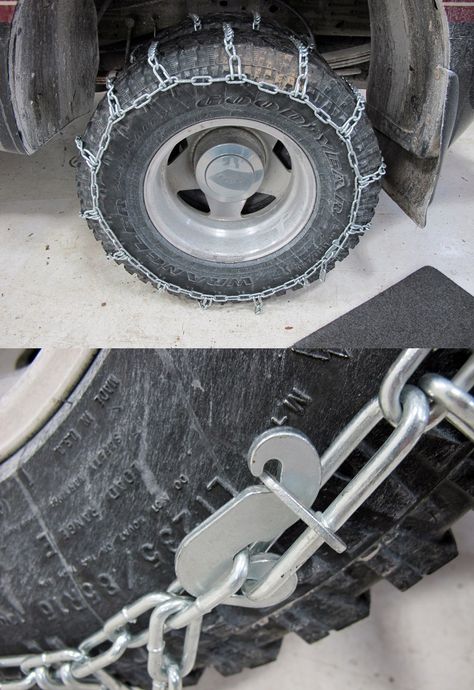 Using pliers to pry the cross chain connecting link open and unhook (the connecting links are not made of hardened steel) or use bolt cutters
Using pliers to pry the cross chain connecting link open and unhook (the connecting links are not made of hardened steel) or use bolt cuttersNOTE: It is important to check that you have enough clearance in both rear wheel wells for tire chains. There should be, at minimum, three inches of clearance between the tire and the inside wall and any drive components.
If you find that you still need more traction, some tractors have wheel weight kits that mount on the outside of the rim, or “suitcase” styled weights to add to a rear weight bar bracket, if available as an accessory. Contact our sales team with model information for price and availability.
We carry lawn tractor tire chains for a variety of tire sizes. There are no universal tire chains; they are specific to and sold by tire size. Contact our parts team with your tire size, or part number, for pricing and availability.
You May Also Enjoy These Articles:
Fall Lawn Care Tips
Engine Oil Maintenance
Tips For Choosing The Best Riding Mower For Your Lawn
Buyer’s Guide to Chippers, Shredders, and Vacs
Spark Plug Maintenance
How To Winterize Your Lawn Mower
Why Weingartz?
Weingartz, family owned and operated, began in 1945 as a farm supply store for local Michigan families.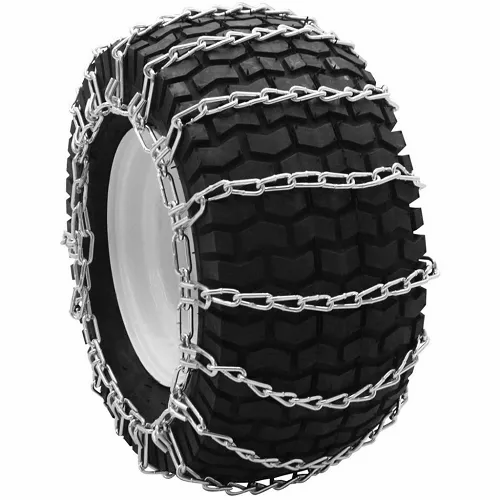 In the 1970s, we began to focus exclusively on outdoor power equipment. Over time, we morphed into the “power equipment superstore” that now defines all of our locations. The staff and experts at Weingartz work diligently to provide the best service possible and give honest and helpful advice to each and every customer.
In the 1970s, we began to focus exclusively on outdoor power equipment. Over time, we morphed into the “power equipment superstore” that now defines all of our locations. The staff and experts at Weingartz work diligently to provide the best service possible and give honest and helpful advice to each and every customer.
Weingartz also sells parts for all outdoor power equipment at https://weingartz.com/parts-lookup.
Weingartz
39050 Grand River Ave.
Farmington Hills, MI 48335
(248) 471-3050
[email protected]
Connect With Us!
https://plus.google.com
https://www.facebook.com/WeingartzLawnToSnow
https://twitter.com/Weingartz
http://pinterest.com/MrWeingartz
Learn More About Brand Specific Lawn Tractors
Sign up for our electronic monthly newsletter for discounts and money-saving tips.
« Buyer’s Guide to Chipper Shredder VacsHow to Prune and Care for Trees »
Garden tractor / Lawn mower tire chains sold in pairs (2 chains), will cover two tires. Compare ChainsNOTE: Search includes chains for Compact Tractors. Whether you are using your tractor as a snow plow/blower to clear your driveway, or just need that extra helping hand in dense brush, you will benefit from the extra grip gained from putting on a set of lawn tractor tire chains. Our chains are constructed of durable hardened steel and made to last. Contact An ExpertIf you need help determining the correct fitment for your garden tractor tire chains, please call our experts at 866-437-5883. Tell them the size of your tires the chain style you are interested in. They will ensure that you get the correct tire chains to fit your tractor's tires. What our customers say about us
Ordering from Tire Chains 'R' UsWe have been selling tire chains for over 20 years, priding ourselves on having the lowest prices, fastest shipping, and best customer service. All our lawn chains are sold in pairs and in most cases are pre-fitted for your tire size. If you have any questions at all, please do not hesitate to contact our staff at 866-437-5883 and we would be more than happy to assist you. Varieties of Garden Tractor Tire ChainsWe offer a few different types of lawn tractor tire chains. The most standard/popular types of chains for this application are twist link ladder style with 2-Link or 4-Link spacing. 2 or 4 link describes the link count before the next cross-chain, creating a ladder style effect. Both varieties feature a twist link design. On the 2-link chains, every other chain link has a cross-chain. The benefit of this type of chain is that there is more chain in contact with the ground, which increases traction and makes your ride smoother and more comfortable. 4-link chains, as the name suggests, have a bigger link count between each cross-chain. These durable chains are made from the same hardened steel as the 2-link style. If you are looking for more tire coverage, increased traction, and/or better steering control than a ladder style chain can provide, we also offer H-pattern chains in standard or V-Bar chain types. The V-Bar version of these chains is the more aggressive option. Both varieties of H-pattern chains also feature a twist link design. Care must be taken to avoid spinning the wheels. This may cause marks or damage to the surface you are on, and shorten the life of your chains. All varieties of chains are sold as a pair. |
admin1. Chains on wheels:No Comment on Installation and operation of anti-skid chains for loaders and special equipment
Chains on wheels:No Comment on Installation and operation of anti-skid chains for loaders and special equipment
Snow chains consist of longitudinal and transverse branches, tail branches, locking hooks. The chain elements are connected using link rings (Fig. 1)
Fig.1 Scheme of the anti-skid chain for a loader (honeycomb)
- locking hook;
- transverse branch;
- longitudinal branch;
- tension ring;
- tail branch;
- chain for tension with a lanyard hook;
- additional transverse branch;
- staples for attaching an additional branch.
BEFORE INSTALLING SNOW CHAINS, MAKE SURE THEY CAN BE USED. MINIMUM CLEARANCE BETWEEN WHEELS AND VEHICLE FRAME MUST BE MINIMUM 30mm. OTHERWISE, IN OPERATION OF THE SNOW CHAINS, RAPID ABRASION OF THE SIDE LONGITUDINAL BRANCHES OF THE CHAIN WILL OCCUR, WHICH MAY LEAD TO ITS BREAK AND WINDING THE CHAINS ON THE AXLE.
SNOW CHAIN INSTALLATION
Snow chains are mounted on the driving wheels of the vehicle.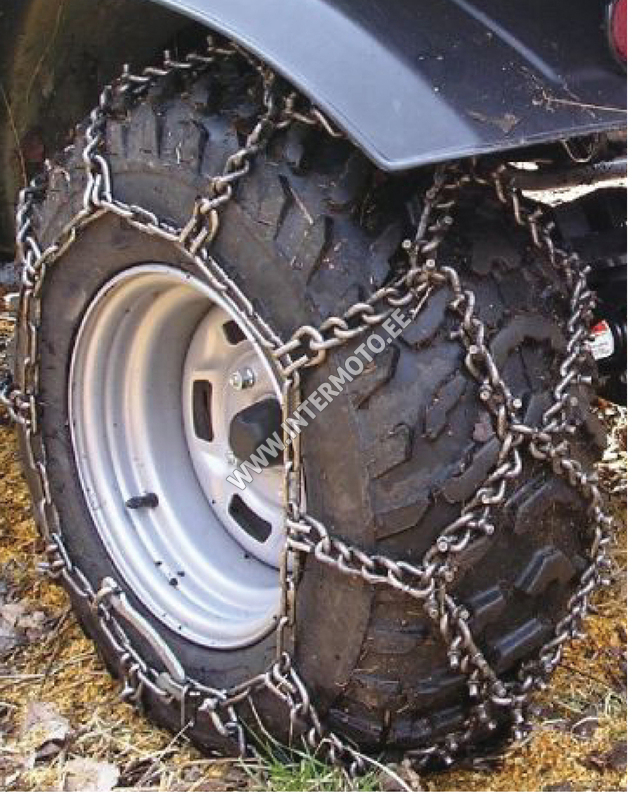 Installation procedure:
Installation procedure:
- fix the vehicle in a position that excludes
spontaneous movement on the road;
put the snow chain on the wheel so that the tensioning rings (pos. 4) are on the outside of the wheel, and the locking hooks (pos. 1) and tail links (pos. 5) are in the lower part of the wheel;
Hook the locking hook (pos. 1) on the inside of the wheel to one of the links of the tail run (pos. 5) or to the ring, i.e. as close as possible to the other half of the snow chains;
spread the transverse branches (pos.2) evenly around the circumference of the wheel;
Hook the locking hook (pos. 1) on the outer part of the wheel side to one of the links of the tail run (pos. 5) or to the ring, i.e. as close as possible to the other half of the snow chains;
pass the tensioning chain (pos. 6) through all the rings (pos. 4), including the ring to which the tensioning chain is attached;
Hook one of the links of the tension chain with the turnbuckle hook and tension it.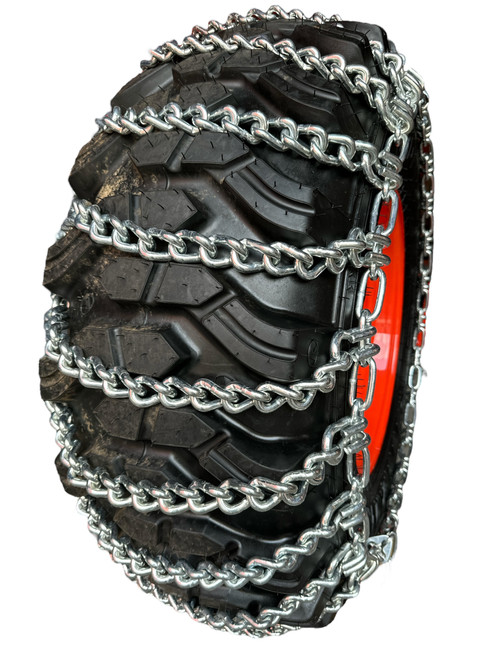 The tension should go until the snow chains fit snugly against the wheel;
The tension should go until the snow chains fit snugly against the wheel;
after movement, if necessary, perform additional chain tension.
Longitudinal and transverse branches must grip the tire tightly. Removing the tool from the wheel is carried out in the reverse order.
Due to the wide variety of actual sizes of tires with the same marking, it may be necessary to install an additional cross leg (item 7) to reduce the space between the Opposite sections and increase the snow chain. To do this, it is necessary to attach an additional branch (pos. 7) to the tail branches (pos. 5) using brackets to one of the links, depending on the required size, to increase it.
OPERATION
The device must be installed immediately before crossing difficult sections of the road, and removed after passing.
Wash and dry the device after use to avoid corrosion. Also, after use, it is necessary to check for cracks and kinks.
The speed of the vehicle with devices put on the wheels must not exceed 30 km/h.
During operation, it is not recommended to drive a vehicle on a hard surface, which sharply abrades the chain links and reduces their resistance and durability.
COMPLETE
The set of snow chains includes:
snow chains — 2 pcs.;
packing bag - 1 pc.;
operating and installation instructions — 1 pc.
chains, loader chains, snow chains
Snow chains are not used daily and often get in the way in the trunk of a car, but there are situations when further movement without chains on the wheels is simply impossible and then they become for the driver, the same necessity as a can or a first aid kit. Often, the tread of standard wheels, all-wheel drive and low gear are enough to overcome puddles and mud on country roads.
But sometimes it is necessary to overcome those last few kilometers to the destination (dacha, mushroom meadow or treasured fishing place) along a country road covered with snow or muddy from rains and broken by timber trucks. In such cases, snow chains come to the rescue.
In such cases, snow chains come to the rescue.
Anti-skid chains (“muzzles” or “purses”, as they are popularly called) increase the cross-country ability of any car from OKI to URALs, Kamaz and GAZ-66. Of course, you can increase the car's cross-country ability by buying off-road tires like Goodrich, but for a car that is used more in urban areas with constant driving on paved roads, this is impractical and expensive. And snow chains for increased flotation, of course, win in price and durability compared to off-road tires.
Chains for cars and SUVs are of 2 types: "Ladder" and "Honeycomb". Chain link thickness 5mm or 6mm. Chain locks are strong, reliable and easy to fasten.
The most common chains with a "Ladder" pattern. Their main advantages are low price, ease of mounting on wheels, better traction, they are lighter and easier to operate, require less time to install on wheels.
"Honeycomb" chains - allow you to move more confidently on viscous soils, no jerks when driving, the likelihood of digging is reduced, but at the same time a higher price, the complexity of mounting on wheels and more installation time.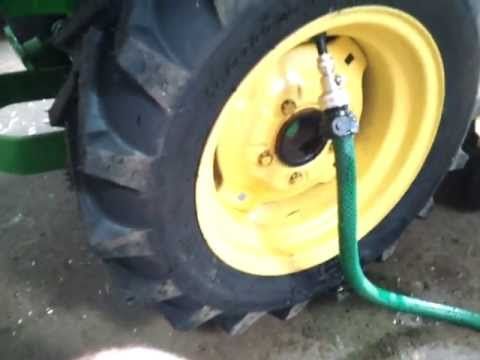
Niva 21213 on snow chains
There are two ways to put the chains on the wheels:
- with jacking up the SUV wheel and then mounting the chains on the wheels.
- with chain spreading and subsequent collision with a car wheel.
For Niva and UAZ, due to the large wheel arches, the method of spreading the chains in front of the front or rear wheels of the car is more suitable. The chains must be laid out on the ground along the axis of movement of the car with the locks outward. Having driven 20 or 30 cm with the front or rear wheels on the chain, we throw most of the chain on the wheel. We pull the chain onto the wheel, pulling the ends together, and with a hook on the inside of the wheel we fasten both parts of the chain. Having straightened the transverse branches of the chain (lugs) on the wheel, we fix the outer lock to the farthest link on the outside of the wheel. After you put both chains on the wheels on one axle of the SUV, you need to drive a few meters to evenly distribute the chain over the surface of the wheel.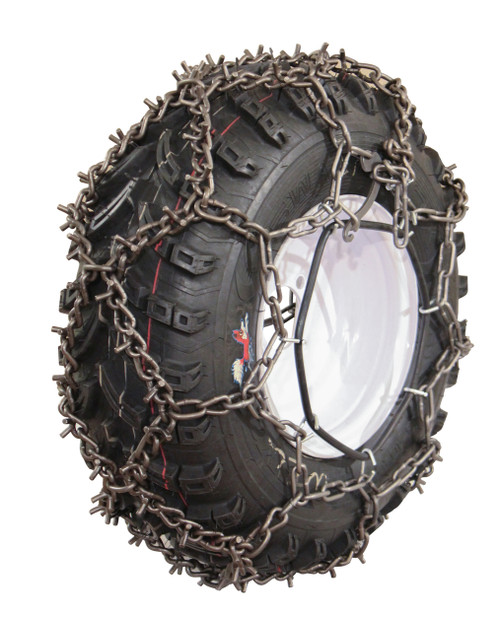 Then, from the outside, you can tighten the chain a few more links and secure it with a locking hook (lock).
Then, from the outside, you can tighten the chain a few more links and secure it with a locking hook (lock).
January. Kirov region. Car VAZ 21213, tires K-182. Chains "Ladder" with a link thickness of 5 mm on the front wheels. Installation of chains took about 15 minutes. Packed snow, crust, snow cover height 40-50cm. When driving, there is a slight drift of the car, to reduce jerks when driving, you have to move in a lower gear in order to have a traction reserve. Having overcome several kilometers through snow-covered fields, I felt like an all-terrain vehicle driver. Permeability has increased exponentially! Slips have been reduced to a minimum, Niva just goes and that's it!
Only the thought of plows and harrows forgotten in the fields by collective farmers, which can catch on and break the chain, was alarming, but everything worked out. The car moved confidently, did not skid. When driving uphill, I had to accelerate a little. When overcoming icy slopes, a slight slip of the front wheels is felt, due to gaps of 200-250 mm between the transverse jumpers.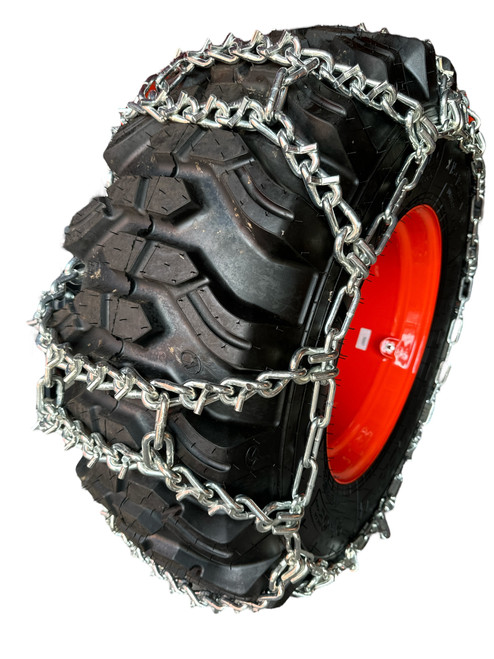
In the winter of the same year, when turning, the rear wheel jumped into an icy track and got stuck. Having jacked up the rear wheel, put the straightened chain under the slipping wheel in the direction of travel and calmly left without outside help. The chains also helped in overcoming a small-looking stream in the spring, which gave us a lot of trouble. Deciding to skip the stream without chains, he landed the car just in the middle of the channel and at the slightest attempt to turn back, the Niva dug deeper and deeper into the clay. The wheel tread instantly clogged with semi-liquid clay and became smooth. The whole family had to dig out the front wheels, jack them up and put on chains up to the elbow in clay and mud. With the chains on, he turned the wheels all the way and reversed. The car jumped out of the rut and drove effortlessly back onto dry land. After that, taking a little to the right, so as not to fall into its own rut, with acceleration effortlessly, my SUV overcame the ill-fated obstacle. After that, I was once again convinced of the need to put on chains before overcoming an obstacle, and not to suffer then to pull them in cold water and elbow-deep in mud. Previously, without chains, when I sat down, I could no longer get out without outside help. Now with the chains I came to the conclusion - before the mud, immediately put them on, you need to move on them evenly, do not skid once again in the mud.
After that, I was once again convinced of the need to put on chains before overcoming an obstacle, and not to suffer then to pull them in cold water and elbow-deep in mud. Previously, without chains, when I sat down, I could no longer get out without outside help. Now with the chains I came to the conclusion - before the mud, immediately put them on, you need to move on them evenly, do not skid once again in the mud.
Experience in using chains on 2111
We drove at the beginning of winter to the country house on the VAZ-2111. In summer, the road there is normal, covered with gravel, and in winter it is not cleaned for several kilometers and, accordingly, snow fell knee-deep there. The temperature for several days was +2 degrees, so the snow was wet and loose. A VAZ-2111 car on winter tires Amtel NordMaster K-239 175/65 R14, faced with wet, heavy snow, stalled after a few meters and refused to go forward. Having passed a few meters back, on a less snowy road surface, I decided to try out snow chains. The snow chains were galvanized, Lasenka type, made specifically for the size of my wheel. Since the vases of the 10th family are characterized by small arches, the transverse branches (lugs) of the chain were made from a long link chain. I tried to put on chains without jacking up, as on a NIVA or UAZ, alas, it did not work out. The distance between the arch and the wheel is too small so that you can stick your hand into it and put the chains on the wheel. Therefore, I had to get the jack and jack up the front wheels in turn. The installation of the chain on the wheel itself turned out to be simple and there were no difficulties with installation. After driving a few meters, I stopped and tightened the chain by 1 link. After installing the chains, the situation changed dramatically: the car began to easily overcome snowdrifts and snow crossings. Effortlessly stopped and started again anywhere.
Having passed a few meters back, on a less snowy road surface, I decided to try out snow chains. The snow chains were galvanized, Lasenka type, made specifically for the size of my wheel. Since the vases of the 10th family are characterized by small arches, the transverse branches (lugs) of the chain were made from a long link chain. I tried to put on chains without jacking up, as on a NIVA or UAZ, alas, it did not work out. The distance between the arch and the wheel is too small so that you can stick your hand into it and put the chains on the wheel. Therefore, I had to get the jack and jack up the front wheels in turn. The installation of the chain on the wheel itself turned out to be simple and there were no difficulties with installation. After driving a few meters, I stopped and tightened the chain by 1 link. After installing the chains, the situation changed dramatically: the car began to easily overcome snowdrifts and snow crossings. Effortlessly stopped and started again anywhere.